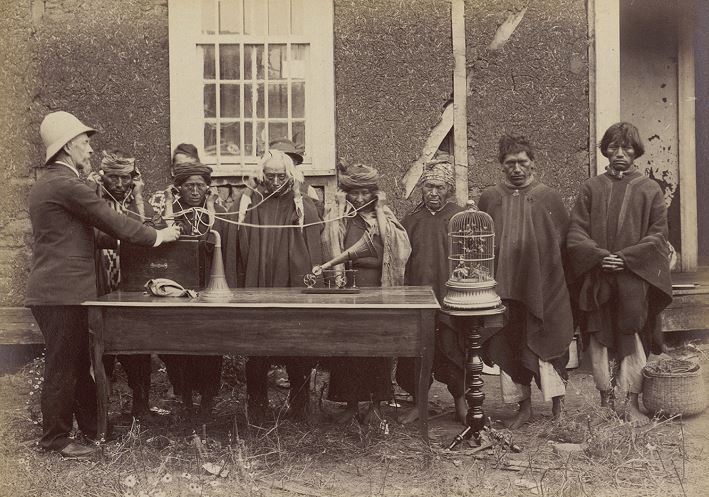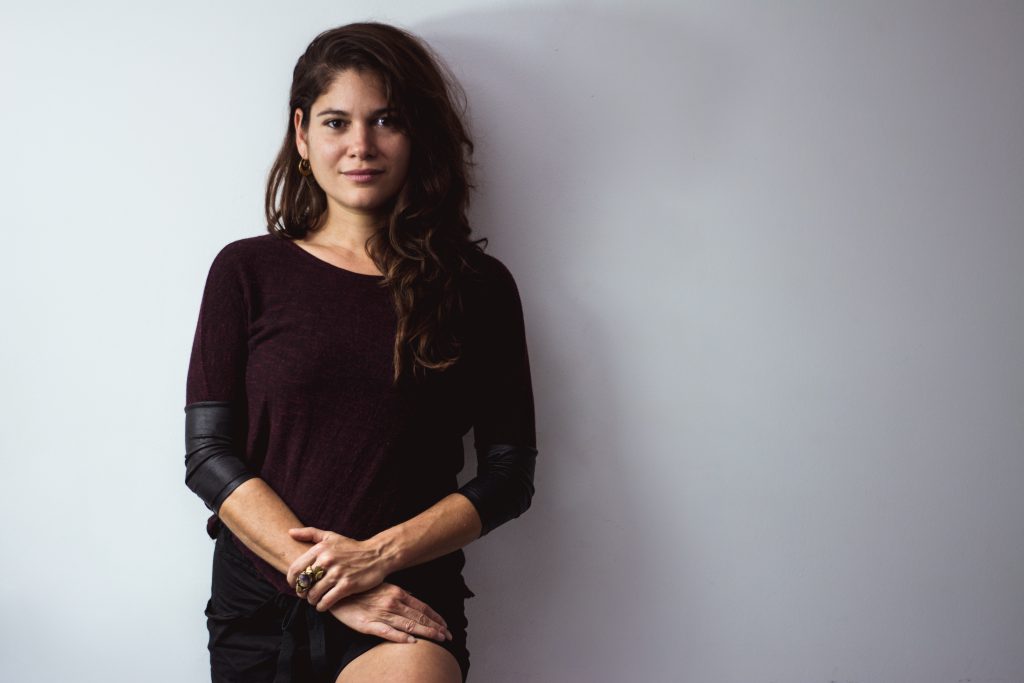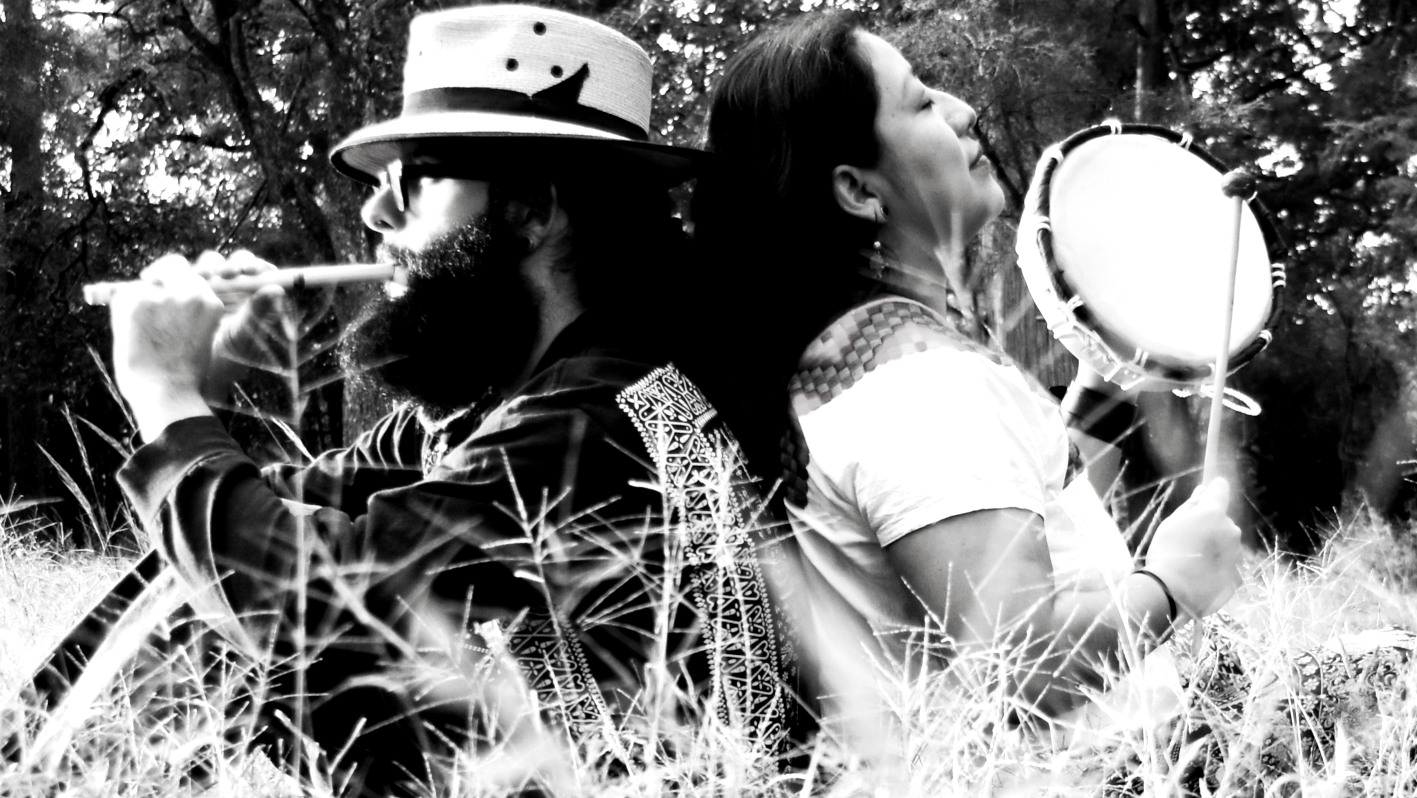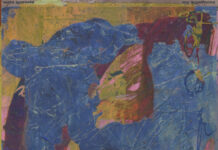Selva y Cerro (Credit: Selva y Cerro).
Lea la versión en español aquí.
From Nicola Cruz to the Mazukamba collective, the so-called organic sound hailing from Central America has been making waves internationally. Despite its strong connections to autochthonous forms of music however, its makers have to grapple with the continuous impact of colonialism in more than one way. Gustavo Gómez presents their visions and dissects the obstacles they have to face.
There is a photo of the Belgian engineer Gustave Verniory, hired by the Chilean government to build a railroad in the Mapuche territory, playing phonographic recordings to a group of Indigenous people. Even though it was taken in 1899, it tells us a lot about how the world as a whole and the world of music more specifically still works. Verniory uses advanced technology to make these unimpressed figures listen to something that surrounds them every day and is entirely natural to them: birdsong.
The picture represents a balance of power between the European in control of the technology and the Indigenous people on the receiving end of the sounds. A parallel can be drawn between that and the many different projects that currently mix traditional music from different parts of the world with elements of electronic music: while many of them hail from the region, the ones who play this regionally specific music come from elsewhere and profit the most from it.

Taken from Verniory’s book “Diez años en la Araucanía, 1889-1899.“
Latin America is an invertebrate being with many divisions and historical interruptions, colonized and, nonetheless, a collective subject. It continuously (re-)constructs its own diverse identity. Decolonization has become a starting point for building a new imagery. This also means that the region’s rich cultural past is being reassessed.
To speak of electronic music in Latin America today is to speak of the reappropriation and resignification of music that is not originally Latin American but which progressively draws on the musical traditions of the region. Western technology has made it possible to mix elements of electronic music with field recordings of sounds from the region, giving them other meaning and picking up on social or environmental themes or topics like gender and ethnicity.
Although no sound recordings of pre-colonial music have been found, textual and graphic inscriptions on ceramic vessels dating from the Classic Period of Mayan Civilization between the 3rd and 10th century indicate that music was a key element in Latin American cultures from Southern Mexico and Central America long before the arrival of the colonizers. It was played and performed at dances, festivities, rituals, and wars. This music is being reinterpreted by a slew of young artists, however, it does not at all receive the same recognition as the sea of releases by North American and European artists.
Slow BPM’s and Unheard Voices
Since the international success of the 2015 album Prender El Alma by the Ecuadorian producer and DJ Nicola Cruz, this mixture of elements has received more and more attention to the point that there is talk about the emergence of a new style of electronic music. In June of this year, the online store Beatport added this supposedly new genre to its catalog. “Organic House / Downtempo” is, according to DJ Mag Latin America, being characterized by the platform as „slower in BPM’s and including tribal sounds and rustic drums.“ It’s a broad description that barely scratches the surface and not only causes confusion in the audience, but also makes invisible the generations of Latin American artists who try to merge pre-colonial musical traditions with contemporary sounds in order to contribute to the redefinition of the continent’s identity.
“In recent years, we’ve noticed a trend towards deeper, more meditative, and occasionally slower shades of house music in various music scenes around the world. As such, Beatport has now launched a new genre, Organic House / Downtempo,“ reads the company’s press release. „By working closely with these communities, we hope their passionate and knowledgeable voices are accurately represented in this new genre that was previously scattered across genres such as Electronic, Deep House, Melodic House & Techno, Afro House and Global Bass.“
But what communities are they referring to? The mixture of elements of electronic music with autochthonous sounds from the region in Latin America has a history of more than a decade, starting with the seminal 2008 albums Rodante, Pibe Cosmo, and La Manita, all released through ZZK Records, by the Argentinian producers Chancha Via Circuito, El Remolón, and Fauna, respectively. This mixture has since been named Tribal House, World Music, Digital Cumbia, Folk-tronic, Electro-Ethnic, etc. However, for the creation of the “new” genre, Beatport did not in fact seek feedback from any Latin American acts but only from distributors, record labels and artists mostly based in Europe and the US like Get Physical, Desert Dwellers or Do Not Sit On The Furniture and Britta Arnold, Oliver Koletzki, Behrouz, Acid Pauli, YokoO, Amine K or Roy Rosenfeld. Yet, the latest releases from ZZK Records, by the Afro-Colombian trio Ghetto Kumbé, were included in the category.
What do these North American and European producers and record labels return to the regions around the world where they take their inspiration from? How much of their income do the Dutch Satori or the US-American Sabo – both usually in the top 100 of “Organic house / Downtempo” on Beatport – return to Mexico, Colombia, Costa Rica, Panama, or South Africa? There are many artists that release electronic music that mixes in the kora or the kalimba, African instruments that have traveled to Latin America during the transatlantic slave trade, or derive their rhythms from Latin American forms. But how much of what is taken from them is being returned to this region and its communities? It seems as if in creating a space „where customers and DJs from around the world can more easily find the artists and labels they already know — or will grow to love — so the sound can thrive and grow,“ as the press release claims, voices from South and Central American or Africa and Asia, who produce music for purposes beyond market strategies, are thoroughly excluded. It’s like Verniory playing birdsong to natives all over again.
As if that were not enough, most Central American promoters will rather book foreign artists than local ones. Touring in Latin America comes with a hefty price tag for regional artists: a flight from Mexico to Argentina, for example, costs more than a flight from Europe to any of these countries, while precarious roads make it almost impossible to organize touring by car. Additionally, local audiences have grown to prefer international artists over local ones, which also contributes to a financial discrepancy between them. While some regional DJs have had the opportunity to play at festivals organized by international brands, they are rarely invited to perform outside of their own region. In 2019, Dekmantel was criticized for putting on festivals in various Latin American cities but not booking any Latin American artists to the editions held in the Netherlands and Croatia. While Latin American music and its derivatives are being played all over the international festival circuit, the movers and shakers of the scene are only rarely seen and the entire community is never fully compensated for its efforts.
The English environmentalist and producer Robin Perkins alias El Búho – founder of the Shika Shika label and an active collaborator of Nicola Cruz, Chancha Via Circuito, the Peruvian Berlin-based duo Dengue Dengue Dengue, Matanza from Chile, and others – says that since the release of Prender El Alma, the scene has become overpopulated with producers who exploit this style and fusion of sounds.
“Now you go to any city in the world and someone is making organic electronic music or medicinal music to accompany anything from meditative practices to hippie fashions that create a demand for a terrible shamanic house,” he says regarding a trend of sampling and using recordings of sacred shamanic songs, something he dismisses as a “disrespectful, objectifying and exoticizing treatment that crosses a fine line between the homage to a tradition, a people, or a culture, and cultural appropriation.” This process, he adds, is now being standardized by stores like Beatport. “Contrary to what they pretend, they actually make it more difficult to find authenticity,” he says.
The Future of Music and Old Problems
Despite all this, a new generation of Central American artists has been reclaiming the sounds and technologies of the native peoples. Even though their music sounds quite different, their art can be understood as an effort to remind Latin America of its roots while also placing it in context of the entire world. The Latin American identity they express with contemporary sounds is both local and global – not constricted to nationalism or monoculturalism, but open and international.
This generation is gathering around the Mazukamba Beats collective, a group of multidisciplinary artists based in Antigua Guatemala. Their objective is to create a community by proposing a diverse and versatile identity based on Latin American and African rhythms that are being fused with electronic sounds. Since 2016, they have held monthly parties that provided their audience with a safe space free from harassment, racism, and drug dealing in which even children are welcome.
One of its founding members is the producer Alex Hentze, who in 2011 traveled to Buenos Aires in the midst of an identity crisis. “I didn’t look contemptuously at Guatemala but I was not excited about having been born there because I did not feel as if I belong there culturally,” he says. Since being a Spanish colony, Guatemala has been a country whose nationality has been built on the denial of the ancestral roots of more than half of the country’s population and structurally preventing their access to and the development of their own creativity through a series of neoliberal interventions.

In those years, Argentina was experiencing a resurgence of Latin American rhythms and a desire to reevaluate its identity. Since 2006, ZZK Records’s headquarter, the Zizek Club in Buenos Aires, has hosted local electronic acts, such as Villa Diamante, Chancha Vía Circuito, DJ Nim, or Frikstailers, that mix electronic music with regional rhythms. They were influenced by Dick El Demasiado amongst others, a Dutch singer, musician and cumbia villera enthusiast who organized the Festicumex: Experimental Cumbia Festivals for the visual and scenic arts.
For Hentze, encountering this mixture of sounds was like arriving at “a future of music.” However, he reiterates that discovering his Latin Americanity did not mean that he was destined to produce digital cumbia or any other particular subgenre as the many artists that influenced him did. In 2017, he released A Helpless Presence, a technically organic electronic album that could not necessarily be cataloged as a folk-tronic record. He describes it as “very personal, like a catharsis of something or someone that lived inside me.” Musically, this meant mixing synthesizers with, among others, útiles sonoros, instruments designed and built by the Guatemalan composer and musician Joaquín Orellana that produce sounds and noises similar to those of the marimba, an ever-present instrument in the Guatemalan soundscape, which was in turn derived from the Mayan xylophones.
On the continent, it is still difficult to live just from music. Alex Hentze also clarifies that, „although I look positively at the growing interest of the audience towards musicians from Latin America and the local scenes, we need more venues with their own developed audiences.” Much like anywhere else in the world, producers in Latin America mostly rely on revenue from playing shows. However, they are not paid quite as much as elsewhere. While in Europe a DJ receives between 500 and 1000 euros on average per performance, a DJ in Central America would need to play at least three or four times as many gigs to earn the same amount.
In addition to offering mixing, mastering, and film scoring services from his home studio, Hentze and the members of the Mazukamba Beats collective, who usually depend on other sources of income, move away from superficial categories, such as the new label imposed upon them by Beatport, if they don’t feel represented by them. “It bothers me that they classify us as Downtempo without asking us if it is suitable”, says Hentze. That’s why they chose to release the first Mazukamba Beats compilation, Savia, via Bandcamp instead of relying on the conventional ways of distribution that the global music industry offers.
Reconnecting With the Past, Connecting With the World
Savia is a DIY product that reflects the collective’s sociopolitical approach to music and art. Its cover design was made by another founding member, the visual artist Parutz, and evokes Gukumatz, the feathered serpent of the K’iche‘ mythology, one of the 22 original Mayan peoples of Guatemala. It includes ten tracks from the same number of artists. Two of them are the Nicaraguan Naoba and the Guatemalan duo Selva y Cerro.

Naoba contributed the percussive vocal track “Dulce Muerte”. In it, the sound artist, DJ and producer, whose real name is Tamara Montenegro, mixes flute sounds and strings with digital pads. “After I tried different genres of electronic music and did not completely identify with any of them and after I was influenced by what Jirondai and Nillo were doing in Costa Rica, I started mixing electronic music with organic sounds and field recordings,” she explains her approach. “This has allowed me to manifest multiple intentions when producing music under this name: delving into the ancestral roots of my experience as a human being, the liberation of the sexuality that is also linked to the nature of the Chorotega people of my native Nicaragua whose members preserve a bisexual identity, and reconnecting with Central America, giving a voice to the original Indigenous Naoba people who lived in Nicaraguan territory until their extinction.”
Selva y Cerro, a duo made up of the sound designer Sonido Quilete and the Maya K’iche‘-Kaqchikel poet Rosa Chávez, declares that they assume their practice as “a political exercise that experiments with digital sounds that go beyond dance music patterns and rather inserts our roots into vocals in the Indigenous Maya K’iche‘ language that in turn are mixed with live instruments, which results in a nexus of worldview, art and ancestral and Western technology”.

One of these elements is the sound of the ronrón, a traditional sound toy that is usually found in local fairs and handicraft sales in Guatemala. It produces a sound similar to that of the whistling of wind in the mountains. They use it in the song „Abuelita Planta (Qati’T Q’Ayes),“ also included on Savia. In their words, their creative process and performances „seek to create textures and environments that go through the experience of the body, the interaction between sonorous bodies with acoustic sediments – ronróns, wooden drums, turtle shells, scrapers, rattles, ocarinas, amongst others – and ancestral materials”. For them, combining this with electronic sounds opens up the possibility of sharing the sounds of the autochthonous peoples with the rest of the world, adds Sonido Quilete, who is also featured on Savia with the solo track „Tamborón corazón„.
“They Want Our Music but Not the Struggle”
Parallel to the continuous construction process of a versatile Latin American sonic identity thanks to artists like Selva y Cerro, Naoba, or Alex Hentze, the impact of colonialism is still noticeable in contemporary music long after the first invasion of the land and the looting of the native peoples of Latin America. Even though their music is being played around the world and continues to inspire others elsewhere, very little comes back in return.
“They want our music but not our struggle. When foreign artists take sounds from native peoples but do not return anything, their aesthetic proposal becomes folkloristic and extractivist,” say Selva y Cerro. “We want to contribute to and build something together with the voices of the peoples that inspire us, making them consciously and respectfully visible.” An example of this resignification is the track „La Abuela y el Maíz,“ in which you hear the voices of the Indigenous Lenca environmentalist Berta Cáceres from Honduras, who was murdered in 2016, and the Maya K’iche‘ land defender Lolita Chávez from Guatemala, who was criminalized in 2012 for denouncing the construction of a hydroelectric project by a company owned by Florentino Pérez, president of Real Madrid, on a river that would affect at least 30 thousand indigenous Q’eqchíes who live in surrounding regions. Integrating these violently oppressed points of view into the bright sounds of the track means giving those silenced voices a chance to express themselves while exposing the continuity of neo-colonialism.
It is within this framework that this new generation of Latin and Central American producers reappropriates and resignifies electronic music, a musical genre that has a history of more than 50 years in Latin America. In spite of local bureaucracy or the national state’s absence from the cultural sphere, various scenes emerged trying to forge a new identity. It is a continuous process that involves the entire continent and which is currently transforming and being shared with the world. However, these efforts are still met with practices that both generalize and exoticize this new diverse Central American identity, catering to audiences that prefer that which to them seems foreign.
It seems that today, Latin American artists can take two different paths. They could either give in to the hegemonic power and neocolonial structures that continue to shape the music industry in Central America and the rest of the world, pursuing a distribution model that depends on foreign validation. A model that in some cases is also based on booking international artists in exchange for a warm-up slot or a deal with venues, brands, and booking agencies in order to leave Latin America in search for scenes with a more robust infrastructure, like the Peruvians Dengue Dengue Dengue, who are currently based in Berlin, or artists from the Mexican label NAAFI, who have been frequently playing on the European festival circuit in recent years.
They could, on the other hand, also dare to be the ones to not only build an aesthetic and sonic landscape, but also organize around matters like a just redistribution of wealth on the global scene, negotiating fair deals with international record labels, distributors, and promoters, claiming respect and reciprocity from other communities and incessantly questioning how the scene can influence the social inequality pervasive in most Latin American countries. Their music is already being heard; their voices still need to be listened to.
This article is part of the Global GROOVE: Electronic Music Journalism series, hosted by GROOVE in collaboration with the Goethe-Institut. Read all other articles here.
Gustavo Gómez was born and raised in Guatemala City. At the beginning of 2020, he moved to the Triple Border between Paraguay, Brazil, and Argentina, to assume a scholarship in Cultural Mediation at the Federal University of Latin American Integration of Brazil. Since 2017, he has been running the blog It’s(not)all about music.





